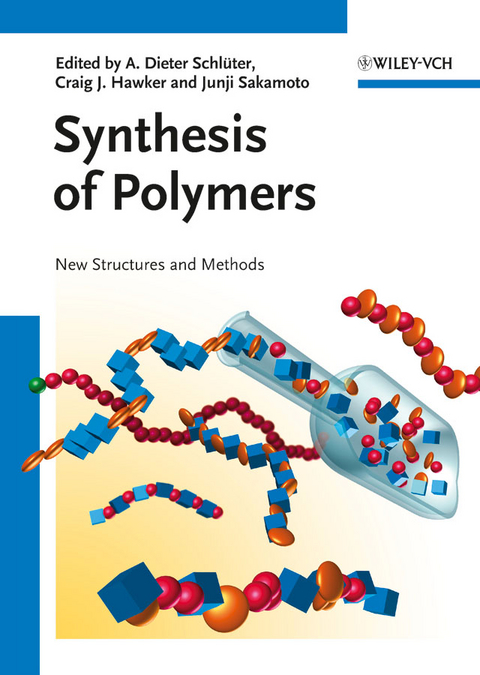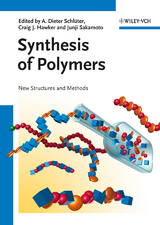Synthesis of Polymers
Wiley-VCH (Verlag)
978-3-527-32757-7 (ISBN)
- Titel ist leider vergriffen;
keine Neuauflage - Artikel merken
Polymers are huge macromolecules composed of repeating structural units. While polymer in popular usage suggests plastic, the term actually refers to a large class of natural and synthetic materials. Due to the extraordinary range of properties accessible, polymers have come to play an essential and ubiquitous role in everyday life - from plastics and elastomers on the one hand to natural biopolymers such as DNA and proteins on the other hand. The study of polymer science begins with understanding the methods in which these materials are synthesized. Polymer synthesis is a complex procedure and can take place in a variety of ways. This book brings together the "Who is who" of polymer science to give the readers an overview of the large field of polymer synthesis. It is a one-stop reference and a must-have for all Chemists, Polymer Chemists, Chemists in Industry, and Materials Scientists.
A. Dieter Schlüter is since 2004 Professor for polymer chemistry at the Materials Department of the ETH Zürich. He studied chemistry and geophysics at the University of Munich and received in 1984 his PhD under the supervision of Prof. G. Szeimies. After post-doctoral fellowships with Prof. K. P.C. Vollhardt (UC Berkeley, USA) and Prof. W.J. Feast (University of Durham, UK) he was head of the polymer synthesis research group in Prof. G. Wegner's department at the Max-Planck-Institut für Polymerforschung (Mainz, Germany). 1991 he finished his habilitation, received a scholarship award of the Fonds der Chemischen Industrie and started as Professor for polymer chemistry at the University of Karlsruhe. From 1992 to 2004 he was Full Professor at the Free University of Berlin. Since 2012 he is an elected personal member of the Swiss Academy of Engineering Sciences. His research interests are in the area of polymer synthesis with a visible component of organic chemistry. Craig J. Hawker, FRS received his BSc (1984) degree from Queensland, Australia his PhD (1988) degree from the Cambridge (UK), followed by a post-doctoral fellowship with Professor Jean M.J. Fréchet at Cornell from 1988 to 1990. In 2005 he moved from the IBM Almaden Research Center to the University of California, Santa Barbara where he is the Heeger Chair of Interdisciplinary Science. He is also the Director of the Materials Research Laboratory, founding Director of the Dow Materials Institute and visiting Chair Professor at King Fahd University of Petroleum and Minerals. His research activities focus on synthetic polymer chemistry and nanotechnology and has led to more than 45 patents and over 300 papers. He has received a number of awards for his work and in 2010 he was named as a Fellow of the Royal Society. Junji Sakamoto is currently a Habilitand at the Swiss Federal Institute of Technology (ETH) Zurich. Born in Kyoto, Japan in 1973, he studied chemistry and polymer science at Kyoto University, and earned his PhD in 2002 on the synthesis of polysaccharides under the supervision of Prof. S. Kobayashi. He carried out his postdoctoral research with Prof. K. Müllen at the Max-Planck-Institute for Polymer Research in Mainz, Germany, working on the synthesis of dendrimers (2002-2004). He then moved to the group of Prof. A.D. Schlüter at ETH Zurich, Switzerland, working on the synthesis of macrocycles, where since 2006 he has been a group leader for 2D polymers, Suzuki polycondensation and new polymerization methodology leading to unprecedented structures.
LIST OF CONTRIBUTORS
CONTENT OF VOLUME 1
FOREWORD
References
POLYMER SYNTHESIS: AN INDUSTRIAL PERSPECTIVE
About this Chapter
Why?
Thesis: There Are No Limits to the Fantasy of a Synthetic Polymer Chemist
Antithesis: We May Be Able to Synthesize Millions of New Polymers - But Why Should We Do So?
Synthesis
Conclusions
FROM HETEROGENEOUS ZIEGLER?NATTA TO HOMOGENEOUS SINGLE-CENTER GROUP 4 ORGANOMETALLIC CATALYSTS: A PRIMER ON THE COORDINATION POLYMERIZATION OF OLEFINS
Introduction
Chapter Prospectus
Fundamentals of Coordination Polymerization
Homogeneous Single-Center Coordination Polymerization
Conclusions
COBALT-MEDIATED RADICAL POLYMERIZATION
Introduction
Mechanistic Considerations
Key Parameters of CMRP
Macromolecular Engineering
Cobalt-Mediated Radical Coupling (CMRC)
Summary and Outlook
ANIONIC POLYMERIZATION: RECENT ADVANCES
Background
Living Anionic Polymerization of Various Monomers
(Meth)acrylate Derivatives Acrylamide Derivatives
Acrylamide Derivatives
Cyclic Monomers
Other Monomers
Reaction of Living Anionic Polymers with Electrophiles: Synthesis of Chain-Functionalized Polymers
Synthesis of Architectural Polymers via Living Anionic Polymerization
Anionic Polymerization: Practical Aspects
Concluding Remarks
ALKYNE METATHESIS POLYMERIZATION (ADIMET) AND MACROCYCLIZATION (ADIMAC)
Introduction
Catalyst Development
Poly(Phenylene Ethynylene)s via ADIMET
ADIMAC-Acyclic Diyne Metathesis Macrocyclization
Conclusions
THE SYNTHESIS OF CONJUGATED POLYTHIOPHENES BY KUMADA CROSS-COUPLING
Introduction to Polythiophene
Kumada Cross-Coupling
Polythiophenes by Kumada Cross-Coupling
Copolymers
Summary and Outlook
"ABSOLUTE" ASYMMETRIC POLYMERIZATION WITHIN CRYSTALLINE ARCHITECTURES: RELEVANCE TO THE ORIGIN OF HOMOCHIRALITY
Introduction
"Through-Space" Asymmetric Polymerization in Inclusion Complexes and Liquid Crystals
Isotactic Oligomers Generated within Monolayers at the Air?Water Interface
"Absolute" Asymmetric Polymerization in 3-D Crystals
Generation of Isotactic Oligopeptides via Polymerization in Racemic Crystals
Isotactic Oligopeptides from the Polymerization of Racemic ValNCA or LeuNCA in Aqueous Solution
Racemic ß-Sheets in the Polymerization of a-Amino-Acids in Aqueous Solutions: Homochiral Oligopeptides and Copeptides via the "Ehler-Orgel" Reaction
Isotactic Oligopeptides from Racemic Thioesters of DL-Leu and DL-Val
Conclusions
SYNTHESIS OF ABIOTIC FOLDAMERS
Introduction
Phenylene Ethynylene Foldamers
Helical Aromatic Amides
Helical Aromatic Ureas
Helical Aromatic Hydrazides
Heterocyclic Foldamers
Conclusions
CYLINDRICAL POLYMER BRUSHES
Introduction
Synthesis of CPBs
Properties of CPBs
CPBs as a Template for 1-D Inorganic/Hybrid Nanostructures
Closing Remarks
BLOCK COPOLYMERS BY MULTI-MODE POLYMERIZATIONS
Introduction
Coupling Methods
Transformation Reactions
Dual Polymerizations
Conclusions
ADVANCES IN THE SYNTHESIS OF CYCLIC POLYMERS
Introduction
Bimolecular Approach
Unimolecular Approach
Ring-Expansion Approach
Conclusions
CYCLODEHYDROGENATION IN THE SYNTHESIS OF GRAPHENE-TYPE MOLECULES
Introduction
Lewis Acid-Catalyzed Oxidative Cyclodehydrogenation (Scholl Reaction)
Base-Induced Cyclodehydrogenation
Oxidative Photocyclization (Mallory Reaction)
Surface-Assisted Cyclodehydrogenation
Conclusions
POLYMERIZATIONS IN MICRO-REACTORS
Introduction
Polymerization Reactions with Excess Heat Production
Formation of Uniform Particles
Scaling-Up
Conclusions
MINIEMULSION POLYMERIZATION
Introduction
Radical Polymerization
Controlled Radical Polymerizations
Radiation-Induced Polymerization
Metal-Catalyzed Polymerizations
Ionic Polymerizations
Polyaddition
Polycondensation
Enzymatic Polymerization
Oxidative Polymerization
New Synthetic Approaches in Miniemulsion
Conclusions
NEW CONJUGATED POLYMERS AND SYNTHETIC METHODS
Introduction
New Polymers Prepared via Chain-Growth Methods
Mechanism
Remaining Limitations
Conclusions and Outlook
POLYCATENANES
Introduction
Main-Chain Polycatenanes
Side-Chain Polycatenanes
Polymeric Catenanes
Catenane Structures in Polymer Networks
Conclusions and Perspective
MULTICYCLIC POLYMERS
Introduction
Ring Polymers with Branches ("Tadpoles")
Dicyclic Polymers
Tricyclic and Tetracyclic Polymers
Oligocyclic Polymers
Conclusions and Perspectives
CONTENT OF VOLUME 2
RING-OPENING METATHESIS POLYMERIZATION
Introduction to Ring-Opening Metathesis Polymerization (ROMP)
Well-Defined Transition Metal-Based Initiators for ROMP
Latent Initiators for ROMP
"Living" ROMP
Summary and Outlook
RECENT ADVANCES IN ADMET POLYCONDENSATION CHEMISTRY
Introduction
Functionalized Polyethylenes
Functional Polymers and Materials via ADMET
Exotic Polymer Structures
Summary and Outlook
MACROMOLECULAR ENGINEERING VIA RAFT CHEMISTRY: FROM SEQUENTIAL TO MODULAR DESIGN
Introduction
Sequential Design
Modular Design
Conclusions
SUZUKI POLYCONDENSATION
Introduction
General Remarks
How to Perform SPC, and Aspects of Characterization
Recent Progress in Broadening the Scope of SPC
Selected Examples of Polyphenylenes and Related Polymers by SPC
Conclusions and Outlook
ENZYMATIC POLYMERIZATION
Introduction
Enzymatic Synthesis of Phenolic Polymers
Enzymatic Synthesis of Polyesters
Concluding Remarks
HYPERBRANCHED POLYMERS: SYNTHESIS AND CHARACTERIZATION ASPECTS
Introduction
Synthetic Methodologies
Characterization Aspects
Separation Techniques for hb Polymers
Size Determination and Scaling Parameters of hb Polymers
Conclusions
EMULSION POLYMERIZATION
Introduction
Molecular Description of Emulsion Polymerization
Radical Polymerization Kinetics in Emulsion Polymerization
Conclusion
CARBOCATIONIC POLYMERIZATION
Introduction
Mechanistic and Kinetic Details of Living Cationic Polymerization
Living Cationic Polymerization
Functional Polymers by Living Cationic Polymerization
Telechelic Polymers
Macromonomers
Linear Diblock Copolymers
Linear Triblock Copolymers
Block Copolymers with Nonlinear Architecture
Branched and Hyperbranched Polymers
Surface Initiated Polymerization - Polymer Brushes
Conclusions
FROM STAR-LIKE TO DENDRIMER-LIKE POLYMERS
Introduction
Essential Features and Properties of Stars and Dendrimer-Like Polymers
General Methods for the Synthesis of Star Polymers
General Methods for the Synthesis of Dendrimer-Like Polymers
Conclusions
TWO-DIMENSIONAL POLYMERS
Introduction
Why 2-D Polymers?
What Is Not Considered a 2-D Polymer?
General Considerations on Rational 2-D Polymer Synthesis
Approaches to 2-D Polymers and Related Structures
Conclusions and Outlook
POLY( PARA-PHENYLENE VINYLENE)S
Introduction
Step-Growth Syntheses of PPVs
Chain-Growth Syntheses of PPVs
Conclusions and Outlook
"CLICk" CHEMISTRY IN POLYMER SCIENCE: CUAAC AND THIOL-ENE COUPLING FOR THE SYNTHESIS AND FUNCTIONALIZATION OF MACROMOLECULES
Introduction and Perspective
Polymers from "Click" Chemistry
Summary and Conclusions
CARBENES IN POLYMER SYNTHESIS
Introduction to Carbenes
Carbenes as Structural Components of Macromolecules
Carbene-Based Polymerization Catalysts
Conclusions
POLYMERIZATION IN CONFINED GEOMETRIES
Introduction
Polymer Synthesis in Organic Hosts
Polymerization in Inorganic Hosts
Polymer Synthesis in Organic - Inorganic Hybrid Hosts
Summary and Conclusions
ACCELERATED APPROACHES TO DENDRIMERS
Introduction
Classification and Synthesis
Accelerated Synthesis of Dendrimers
Summary and Conclusions
SUPRAMOLECULAR POLYMERS
Introduction
Supramolecular Chemistry
Supramolecular Polymerization Mechanisms
Examples of Supramolecular Polymers
Supramolecular Polymeric Materials
Future Perspectives
NUCLEIC ACID POLYMERS AND DNA SYNTHETIC POLYMER HYBRID MATERIALS GENERATED BY MOLECULAR BIOLOGY TECHNIQUES
Introduction
DNA Hydrogels Mediated by the Action of DNA Ligases
DNA Block Copolymers and DNA Networks Generated by the Polymerase Chain Reaction
Generating DNA - Synthetic Polymer Hybrids with DNA Polymerases
Plasmids and Catenated Nucleic Acid Architectures from Circular DNA Molecules
Conclusions
CYCLODEXTRIN-BASED PLYROTAXANES
Rotaxanes
Polyrotaxanes
Rotaxanes Containing CDs
Polyrotaxanes Containing CDs
Formation of Gel by Mixing Host Polymers and Guest Polymers
Tubular Polymers
DENDRONIZED POLYMERS: AN APPROACH TO SINGLE MOLECULAR OBJECTS
Introduction
Synthesis
Quantification of Thickness
Responsivity of Dendronized Polymers
Manipulation on Surfaces and Building Objects
Conclusions
INDEX
| Erscheint lt. Verlag | 12.4.2012 |
|---|---|
| Reihe/Serie | Materials Science and Technology Series |
| Verlagsort | Weinheim |
| Sprache | englisch |
| Maße | 170 x 240 mm |
| Gewicht | 2564 g |
| Themenwelt | Naturwissenschaften ► Chemie ► Organische Chemie |
| Technik ► Maschinenbau | |
| Schlagworte | Biomaterialien • biomaterials • Chemie • Chemistry • Materials Science • Materialwissenschaften • Methods - Synthesis & Techniques • Methods - Synthesis & Techniques • Organische Chemie • Organische Chemie / Methoden, Synthesen, Verfahren • Organische Synthese • Polymere • Polymerisation • Polymer Science & Technology • Polymer Science & Technology • Polymersynthese • polymer synthesis • Polymerwissenschaft u. -technologie |
| ISBN-10 | 3-527-32757-6 / 3527327576 |
| ISBN-13 | 978-3-527-32757-7 / 9783527327577 |
| Zustand | Neuware |
| Haben Sie eine Frage zum Produkt? |
aus dem Bereich




